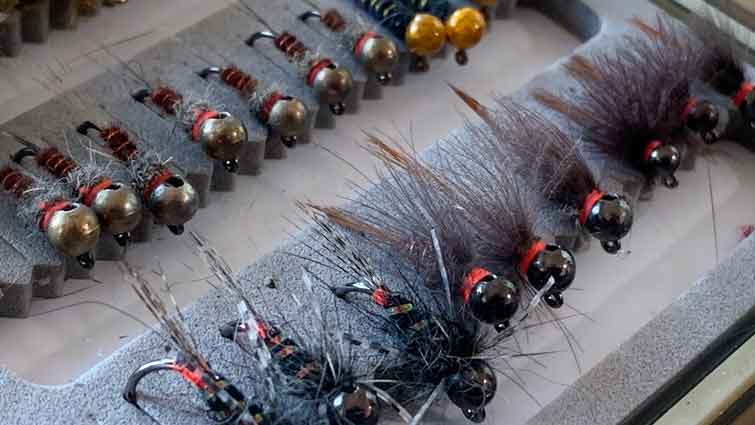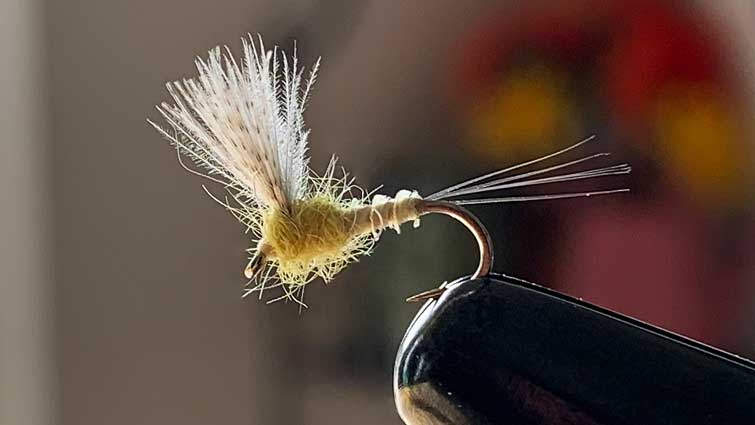Euro nymphing has become one of the fastest-growing forms of fly fishing, with thousands of anglers participating worldwide. However, it still doesn't have the same number of participants as traditional fly fishing.
Euro Nymphing is a form of fly fishing. It refers to a type of trout fishing that began with competitive fly fishing events. Longer thinner leaders attached to heavier point flies and droppers are utilized. In place of an indicator (bobber), a "sighter" (multi-colored section of monofilament) is used.
Euro nymphing differs from traditional nymphing because there is no weight tied to the bottom of the mainline, so it hangs straight down off the tip of your rod, which means you have more control over your connection between your fly and your line. This article will look at the similarities between traditional fly fishing and euro nymphing.

What is Euro Nymphing?
Euro nymphing has become one of the fastest-growing forms of fly fishing, with thousands of anglers participating worldwide. However, it still doesn't have the same number of participants as traditional fly fishing.
Euro nymphing refers to a type of trout fishing that began with competitive fly fishing events. Euro Nymphing is a fly fishing method in which an angler holds a sighter off the water to detect when a trout has eaten their weighted flies.
Euro nymphing is still used in tournaments today but is no longer restricted by the same rules that governed its inception. Euro nymphing differs from traditional because there is no weight tied to the bottom of the mainline, so it hangs straight down off the tip of your rod, which means you can cast much farther because there's nothing weighing down your casting capabilities.

A Euro Nymphing rig is basically a long leader of about ten ft. or more with no tippet (the butt section of the line) attached, also called the mainline. The flies are fastened to small sections of monofilament (sighter), which act as indicators - these are tied onto the end of the fly lines via various methods like loops or tiny tubes designed for attaching it to different sections on your leader (called droppers.)
Because there's no weight attached at the bottom of your rig, you can cast far and mend more easily; plus, it makes mending super important because if you don't mend properly, your flies will drift from where you want them at a much faster rate than regular fishing.
What is the Difference Between Traditional Fly Fishing and Euro Nymphing?
Euro Nymphing differs from traditional fly fishing in that there is no weight tied to the bottom of the mainline, so it hangs straight down off the tip of your rod. The significant distinction between euro nymphing and traditional nymphing is that the angler maintains a close link between the flies and the rod tip throughout the drift.
The main difference between European Nymphing and traditional setups has minor changes that make the system more efficient in getting the flies in the correct zone quicker. With Euro Nymphing, no indicator (suspension device) floats on the surface. Your indicator is incorporated into the leader itself (sighter).

This serves two purposes. First, it provides a visual clue by deviating or pausing during the drift. Secondly, this in-line system will tell you what the flies are doing below the surface since the indicator/sighter will always point to where the flies are. For example, you make a cast and hit a faster current sweeping away from your position in the stream, the indicator/sighter will point at the opposite bank, and the flies will sweep high in the water column instead of sinking.
In traditional fly fishing, a split shot or bead is tied to the end of the leader/tippet. This slows down how fast your flies reach the fish's feeding zone. Thicker leaders and additional indicators create drag. With a limited size tippet and direct connection to your fly in Euro Nymphing, the fly, when cast, cuts through the water faster and to the feeding zone sooner, covering more extensive sections of water.
The Benefits of Euro Nymphing
The benefits of Euro Nymphing are plentiful. European nymphing differs from regular fly fishing by having no indicator (suspension device) that floats on the surface. Your indicator is incorporated into the leader itself (sighter).
The benefits of this type of system are that it provides a visual clue by deviating or pausing during the drift and tells you what your flies are doing below water since the indicator will always point to where your flies are. As mentioned above, there is a weight attached at the bottom of your rig in traditional fly fishing, which makes casting far and mending easier, but with euro nymphing, these weights aren't necessary.

This type of system allows for more accurate casts and more control over your line on the water. You can also cover more water, thus increasing your chances of catching fish.
Some additional benefits include:
- The ability to reach greater distances with 10′ or longer rods while maintaining the same drift depth by raising or lowering instead of changing the weight or moving indicator
- The short distance and constant connection to the flies lead to increased hook up rates
- Euro nymphing provides improved strike detection via a direct connection.
- It is easy to move flies for an induced take with a lift of the rod when Euro nymphing
- Improved fish fighting ability and better angles when landing fish (better leverage and angle)

Euro Nymphing in Competition
With the ever-growing popularity of European Nymphing, it is no wonder that both private and corporate interests have been exploring their potential in competitive situations.
Euro Nymphing is used in many different aspects of fly fishing, such as competitive fishing and regular day-to-day activities. Euro nymphing is the best way to catch fish in fast-moving or topwater conditions without worrying about a additional line drag and mending.
As we discussed earlier, Euro nymphing differs from traditional because there is no weight tied to the bottom of the mainline, so it hangs straight down off the tip of your rod. But the downside to Euro nymping is there is less weight in the fly line, it makes it more difficult to cast long distances and keep a clean connection.
Why Is Euro Nymphing So Effective?
Because it eliminates various sources of drag in your drift, Euro nymphing is very efficient. You may begin to fish water that would otherwise be difficult to fish with standard setups by using a long leader that you can hold off the water with minimal sag.
Euro Nymphing is effective because the flies are always in direct contact with the leader. This means that even though there isn't any lead on your line, you can still keep your flies at the depth where they're most effective. Strike detection increases because of this connection from fly to the leader to hand.

Is Euro Nymphing Easy?
Euro Nymphing is a fly fishing method in which an angler holds a sighter off the water to detect when a trout has eaten their weighted flies. This process differs from traditional fly fishing and may take some time.
Euro Nymphing isn't easy, but it can be simplified. You'll need a few things to get started. A euro leader and Euro Nymphing flies are among essential items. Although it is not crucial, getting a rod designed for Euro Nymphing may be beneficial.
When Euro Nymphing, the casting is initially difficult. You must alter your casting stroke since there is no fly line to load the rod. In a normal fly cast, you overpower your casting stroke to a certain extent.
After executing the cast, the angler holds the rod high to keep the sighter off the water. The flies are then led downstream with the rod tip and sighter.
Flies should be allowed to drift downriver for only as long as it takes to keep up with the current. Consider it keeping up with the flies rather than leading them. If you're walking at a good clip, there will be a little downstream drop in the sighter.
The most challenging aspect of euro nymphing is maintaining this delicate balance. If you're behind the fish, you won't be able to tell when they're feeding. You'll wind up dragging them faster than the current if you lead them too much.
Why Are Euro Nymph Leaders So Long?
A leader is simply a length of material (or materials) that connects your fly line to your fly. The purpose of a fly leader is simple: to link your fly to your fly line in such a way as to assist you in catching fish.
The reason these leaders are so long is due to the fact that any thick substance in or on top of the water will generate some amount of resistance (something that moves your fly strangely). When Euro nymphing, it's typically best to keep all of your line off the surface except for the tippet and flies.

These flies are designed to cut resistance, which means there is no hackle or feathers that lay flat on the surface to keep it floating. Instead, they're tied so that they cut through the water column and create very little disturbance as you walk them downstream.
Since you'll be fishing with most if not all of your line off the water's surface most of the time, you'll need to tie an ultra-light tippet to keep from spooking any fish below the surface. Euro Nymphing is typically done with 4x or less tippet.
Can You Euro Nymph With a Floating Line?
Euro nymphing is usually performed with two or three weighted nymphs, depending on the depth of the water column, current speed, and tension needed to hold the bottom. This technique uses more weight than traditional American-nymph fishing with tapered leaders until flies are within four feet of the bottom.
Euro-nymphing can be practiced with floating lines and long leaders, typically two times the length of your fly rod, and are combined with two or three weighted nymphs. Typical Euro Nymphing fly lines are considered floating but smaller in diameter and denser for improved connection to your flies.
Conclusion
Euro Nymphing isn't for everyone, but it does work. Although the casting may take some time to perfect, and you'll require a bit more patience than with other styles of fly fishing, the rewards at the end justify the learning curve: Bigger fish and more fun!
If you're a fly fishing enthusiast, it's essential to understand the different types of angling that are available. Euro nymphing has evolved into one of the fastest-growing forms in recent years due to its competitive nature and the ability for beginners to get involved. It's challenging to pick up at first. Still, once you get accustomed to using a longer rod and leader along with a slightly different technique, Euro-nymphing is a fantastic way to add variety into your usual fly fishing routine.




